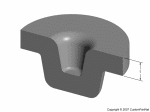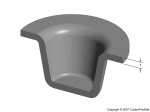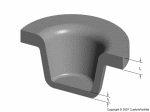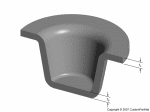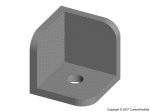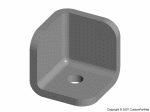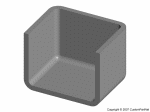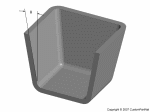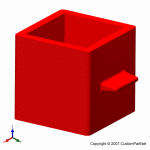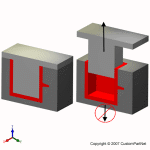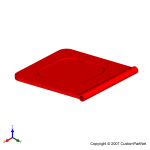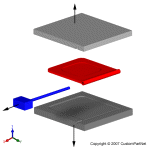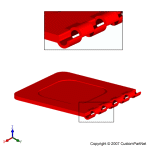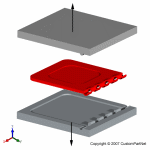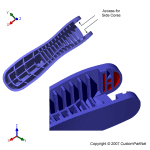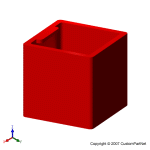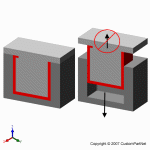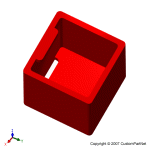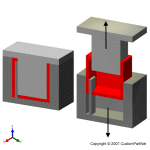- Processes
- Polymer Processing
- Blow Molding
- Injection Molding
- Metal Injection Molding
- Thermoforming
- Metal Casting
- Centrifugal Casting
- Die Casting
- Investment Casting
- Permanent Mold
- Sand Casting
- Shell Mold Casting
- Machining
- Milling
- Turning
- Hole-making
- Drill Size Chart
- Tap Size Chart
- Sheet Metal Fabrication
- Forming
- Cutting with shear
- Cutting without shear
- Gauge Size Chart
- Additive Fabrication
- SLA
- FDM
- SLS
- DMLS
- 3D Printing
- Inkjet Printing
- Jetted Photopolymer
- LOM
- Materials
- Metals
- Plastics
- Case Studies
- Cost Analysis
- Part Redesign
- Product Development
- Resources
- Curriculum Resources
- Glossary
Die casting is a manufacturing process that can produce geometrically complex metal parts through the use of reusable molds, called dies. The die casting process involves the use of a furnace, metal, die casting machine, and die. The metal, typically a non-ferrous alloy such as aluminum or zinc, is melted in the furnace and then injected into the dies in the die casting machine. There are two main types of die casting machines - hot chamber machines (used for alloys with low melting temperatures, such as zinc) and cold chamber machines (used for alloys with high melting temperatures, such as aluminum). The differences between these machines will be detailed in the sections on equipment and tooling. However, in both machines, after the molten metal is injected into the dies, it rapidly cools and solidifies into the final part, called the casting. The steps in this process are described in greater detail in the next section.
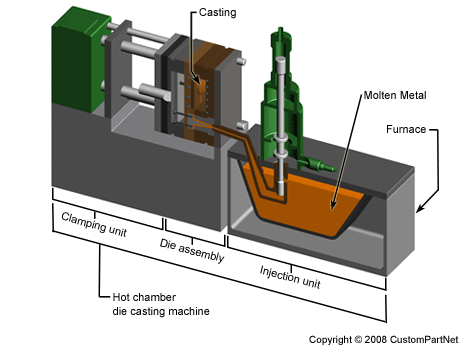 |
| Die casting hot chamber machine overview |
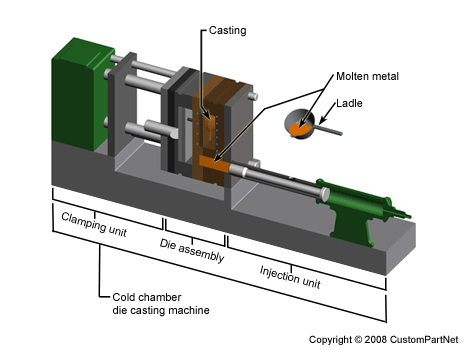 |
| Die casting cold chamber machine overview |
The castings that are created in this process can vary greatly in size and weight, ranging from a couple ounces to 100 pounds. One common application of die cast parts are housings - thin-walled enclosures, often requiring many ribs and bosses on the interior. Metal housings for a variety of appliances and equipment are often die cast. Several automobile components are also manufactured using die casting, including pistons, cylinder heads, and engine blocks. Other common die cast parts include propellers, gears, bushings, pumps, and valves.
Return to top
Capabilities
Disclaimer: All process specifications reflect the approximate range of a process's capabilities and should be viewed only as a guide. Actual capabilities are dependent upon the manufacturer, equipment, material, and part requirements.
Return to top | ||||||||||||||||||||||||||||||||||||||
Process Cycle
The process cycle for die casting consists of five main stages, which are explained below. The total cycle time is very short, typically between 2 seconds and 1 minute.
-
Clamping
- The first step is the preparation and clamping of the two halves of the die. Each die half is first cleaned from the previous injection and then lubricated to facilitate the ejection of the next part. The lubrication time increases with part size, as well as the number of cavities and side-cores. Also, lubrication may not be required after each cycle, but after 2 or 3 cycles, depending upon the material. After lubrication, the two die halves, which are attached inside the die casting machine, are closed and securely clamped together. Sufficient force must be applied to the die to keep it securely closed while the metal is injected. The time required to close and clamp the die is dependent upon the machine - larger machines (those with greater clamping forces) will require more time. This time can be estimated from the dry cycle time of the machine. -
Injection
- The molten metal, which is maintained at a set temperature in the furnace, is next transferred into a chamber where it can be injected into the die. The method of transferring the molten metal is dependent upon the type of die casting machine, whether a hot chamber or cold chamber machine is being used. The difference in this equipment will be detailed in the next section. Once transferred, the molten metal is injected at high pressures into the die. Typical injection pressure ranges from 1,000 to 20,000 psi. This pressure holds the molten metal in the dies during solidification. The amount of metal that is injected into the die is referred to as the shot. The injection time is the time required for the molten metal to fill all of the channels and cavities in the die. This time is very short, typically less than 0.1 seconds, in order to prevent early solidification of any one part of the metal. The proper injection time can be determined by the thermodynamic properties of the material, as well as the wall thickness of the casting. A greater wall thickness will require a longer injection time. In the case where a cold chamber die casting machine is being used, the injection time must also include the time to manually ladle the molten metal into the shot chamber. -
Cooling
- The molten metal that is injected into the die will begin to cool and solidify once it enters the die cavity. When the entire cavity is filled and the molten metal solidifies, the final shape of the casting is formed. The die can not be opened until the cooling time has elapsed and the casting is solidified. The cooling time can be estimated from several thermodynamic properties of the metal, the maximum wall thickness of the casting, and the complexity of the die. A greater wall thickness will require a longer cooling time. The geometric complexity of the die also requires a longer cooling time because the additional resistance to the flow of heat. -
Ejection
- After the predetermined cooling time has passed, the die halves can be opened and an ejection mechanism can push the casting out of the die cavity. The time to open the die can be estimated from the dry cycle time of the machine and the ejection time is determined by the size of the casting's envelope and should include time for the casting to fall free of the die. The ejection mechanism must apply some force to eject the part because during cooling the part shrinks and adheres to the die. Once the casting is ejected, the die can be clamped shut for the next injection. -
Trimming
- During cooling, the material in the channels of the die will solidify attached to the casting. This excess material, along with any flash that has occurred, must be trimmed from the casting either manually via cutting or sawing, or using a trimming press. The time required to trim the excess material can be estimated from the size of the casting's envelope. The scrap material that results from this trimming is either discarded or can be reused in the die casting process. Recycled material may need to be reconditioned to the proper chemical composition before it can be combined with non-recycled metal and reused in the die casting process.
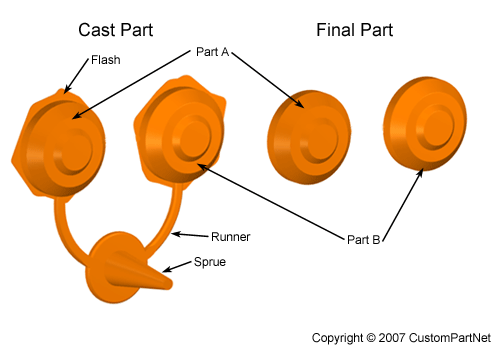
Die cast part
Return to top
Equipment
The two types of die casting machines are a hot chamber machine and cold chamber machine.
-
Hot chamber die casting machine
- Hot chamber machines are used for alloys with low melting temperatures, such as zinc, tin, and lead. The temperatures required to melt other alloys would damage the pump, which is in direct contact with the molten metal. The metal is contained in an open holding pot which is placed into a furnace, where it is melted to the necessary temperature. The molten metal then flows into a shot chamber through an inlet and a plunger, powered by hydraulic pressure, forces the molten metal through a gooseneck channel and into the die. Typical injection pressures for a hot chamber die casting machine are between 1000 and 5000 psi. After the molten metal has been injected into the die cavity, the plunger remains down, holding the pressure while the casting solidifies. After solidification, the hydraulic system retracts the plunger and the part can be ejected by the clamping unit. Prior to the injection of the molten metal, this unit closes and clamps the two halves of the die. When the die is attached to the die casting machine, each half is fixed to a large plate, called a platen. The front half of the die, called the cover die, is mounted to a stationary platen and aligns with the gooseneck channel. The rear half of the die, called the ejector die, is mounted to a movable platen, which slides along the tie bars. The hydraulically powered clamping unit actuates clamping bars that push this platen towards the cover die and exert enough pressure to keep it closed while the molten metal is injected. Following the solidification of the metal inside the die cavity, the clamping unit releases the die halves and simultaneously causes the ejection system to push the casting out of the open cavity. The die can then be closed for the next injection.
Cold chamber die casting machine
- Cold chamber machines are used for alloys with high melting temperatures that can not be cast in hot chamber machines because they would damage the pumping system. Such alloys include aluminum, brass, and magnesium. The molten metal is still contained in an open holding pot which is placed into a furnace, where it is melted to the necessary temperature. However, this holding pot is kept separate from the die casting machine and the molten metal is ladled from the pot for each casting, rather than being pumped. The metal is poured from the ladle into the shot chamber through a pouring hole. The injection system in a cold chamber machine functions similarly to that of a hot chamber machine, however it is usually oriented horizontally and does not include a gooseneck channel. A plunger, powered by hydraulic pressure, forces the molten metal through the shot chamber and into the injection sleeve in the die. The typical injection pressures for a cold chamber die casting machine are between 2000 and 20000 psi. After the molten metal has been injected into the die cavity, the plunger remains forward, holding the pressure while the casting solidifies. After solidification, the hydraulic system retracts the plunger and the part can be ejected by the clamping unit. The clamping unit and mounting of the dies is identical to the hot chamber machine. See the above paragraph for details.
Machine specifications
Both hot chamber and cold chamber die casting machines are typically
characterized by the tonnage of the
clamp force they provide. The required
clamp force is determined by the
projected area
of the parts in the die and the pressure with which the
molten metal is
injected. Therefore, a larger part will require a larger
clamping force. Also, certain materials that require
high injection pressures may require higher tonnage
machines. The size of the part must also comply with
other machine specifications, such as maximum
shot volume,
clamp stroke,
minimum mold thickness, and platen
size.
Die cast parts can vary greatly in size and therefore require
these measures to cover a very large range. As a result,
die casting machines are designed to each accommodate a small
range of this larger spectrum of values. Sample specifications
for several different hot chamber and cold chamber die casting
machines are given below.
| Type | Clamp force (ton) | Max. shot volume (oz.) | Clamp stroke (in.) | Min. mold thickness (in.) | Platen size (in.) |
| Hot chamber | 100 | 74 | 11.8 | 5.9 | 25 x 24 |
| Hot chamber | 200 | 116 | 15.8 | 9.8 | 29 x 29 |
| Hot chamber | 400 | 254 | 21.7 | 11.8 | 38 x 38 |
| Cold chamber | 100 | 35 | 11.8 | 5.9 | 23 x 23 |
| Cold chamber | 400 | 166 | 21.7 | 11.8 | 38 x 38 |
| Cold chamber | 800 | 395 | 30.0 | 15.8 | 55 x 55 |
| Cold chamber | 1600 | 1058 | 39.4 | 19.7 | 74 x 79 |
| Cold chamber | 2000 | 1517 | 51.2 | 25.6 | 83 x 83 |
Return to top
Tooling
The dies into which the molten metal is injected are the custom tooling used in this process. The dies are typically composed of two halves - the cover die, which is mounted onto a stationary platen, and the ejector die, which is mounted onto a movable platen. This design allows the die to open and close along its parting line. Once closed, the two die halves form an internal part cavity which is filled with the molten metal to form the casting. This cavity is formed by two inserts, the cavity insert and the core insert, which are inserted into the cover die and ejector die, respectively. The cover die allows the molten metal to flow from the injection system, through an opening, and into the part cavity. The ejector die includes a support plate and the ejector box, which is mounted onto the platen and inside contains the ejection system. When the clamping unit separates the die halves, the clamping bar pushes the ejector plate forward inside the ejector box which pushes the ejector pins into the molded part, ejecting it from the core insert. Multiple-cavity dies are sometimes used, in which the two die halves form several identical part cavities.
Die channels
The flow of molten metal into the part cavity requires several channels that are integrated into the die and differs slightly for a hot chamber machine and a cold chamber machine. In a hot chamber machine, the molten metal enters the die through a piece called a sprue bushing (in the cover die) and flows around the sprue spreader (in the ejector die). The sprue refers to this primary channel of molten metal entering the die. In a cold chamber machine, the molten metal enters through an injection sleeve. After entering the die, in either type of machine, the molten metal flows through a series of runners and enters the part cavities through gates, which direct the flow. Often, the cavities will contain extra space called overflow wells, which provide an additional source of molten metal during solidification. When the casting cools, the molten metal will shrink and additional material is needed. Lastly, small channels are included that run from the cavity to the exterior of the die. These channels act as venting holes to allow air to escape the die cavity. The molten metal that flows through all of these channels will solidify attached to the casting and must be separated from the part after it is ejected. One type of channel that does not fill with material is a cooling channel. These channels allow water or oil to flow through the die, adjacent to the cavity, and remove heat from the die.

Die assembly - Open (Hot chamber) |

Die assembly - Closed (Hot chamber) |

Die assembly - Exploded view (Hot chamber) |

Die assembly - Opened (Cold chamber) |
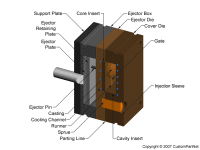
Die assembly - Closed (Cold chamber) |

Die assembly - Exploded view (Cold chamber) |
Die Design
In addition to these many types of channels, there are other design issues that must be considered in the design of the dies. Firstly, the die must allow the molten metal to flow easily into all of the cavities. Equally important is the removal of the solidified casting from the die, so a draft angle must be applied to the walls of the part cavity. The design of the die must also accommodate any complex features on the part, such as undercuts, which will require additional die pieces. Most of these devices slide into the part cavity through the side of the die, and are therefore known as slides, or side-actions. The most common type of side-action is a side-core which enables an external undercut to be molded. Another important aspect of designing the dies is selecting the material. Dies can be fabricated out of many different types of metals. High grade tool steel is the most common and is typically used for 100-150,000 cycles. However, steels with low carbon content are more resistant to cracking and can be used for 1,000,000 cycles. Other common materials for dies include chromium, molybdenum, nickel alloys, tungsten, and vanadium. Any side-cores that are used in the dies can also be made out of these materials.
Return to top
Materials
Die casting typically makes use of non-ferrous alloys. The four most common alloys that are die cast are shown below, along with brief descriptions of their properties. (Follow the links to search the material library).
| Materials | Properties |
| Aluminum alloys |
|
| Copper alloys |
|
| Magnesium alloys |
|
| Zinc alloys |
|
The selection of a material for die casting is based upon several factors including the density, melting point, strength, corrosion resistance, and cost. The material may also affect the part design. For example, the use of zinc, which is a highly ductile metal, can allow for thinner walls and a better surface finish than many other alloys. The material not only determines the properties of the final casting, but also impacts the machine and tooling. Materials with low melting temperatures, such as zinc alloys, can be die cast in a hot chamber machine. However, materials with a higher melting temperature, such as aluminum and copper alloys, require the use of cold chamber machine. The melting temperature also affects the tooling, as a higher temperature will have a greater adverse effect on the life of the dies.
Return to top
Possible Defects
| Defect | Causes |
| Flash |
|
| Unfilled sections |
|
| Bubbles |
|
| Hot tearing |
|
| Ejector marks |
|
Many of the above defects are caused by a non-uniform cooling rate. A variation in the cooling rate can be caused by non-uniform wall thickness or non-uniform die temperature.
Return to top
Design Rules
Maximum wall thickness
- Decrease the maximum wall thickness of a part to shorten the cycle time (injection time and cooling time specifically) and reduce the part volume
- Uniform wall thickness will ensure uniform cooling and reduce defects
Corners
- Round corners to reduce stress concentrations and fracture
- Inner radius should be at least the thickness of the walls
Draft
- Apply a draft angle to all walls parallel to the parting direction to facilitate removing the part from the die.
- Aluminum: 1° for walls, 2° for inside cores
- Magnesium: 0.75° for walls, 1.5° for inside cores
- Zinc: 0.5° for walls, 1° for inside cores
Undercuts
- Minimize the number of external undercuts
- External undercuts require side-cores which add to the tooling cost
- Some simple external undercuts can be cast by relocating the parting line
- Redesigning a feature can remove an external undercut
- Remove all internal undercuts that require lifters - Jamming of these devices often occurs in die casting
- Designing an opening in the side of a part can allow a side-core to form an internal undercut
- Redesigning a part can remove an internal undercut
- Minimize number of side-action directions
- Additional side-action directions will limit the number of possible cavities in the die
Return to top
Cost Drivers
Material cost
The material cost is determined by the weight of material that is required and the unit price of that material. The weight of material is clearly a result of the part volume and material density; however, the part's maximum wall thickness can also play a role. The weight of material that is required includes the material that fills the channels of the die. A part with thinner walls will require a larger system of channels to ensure that the entire part fills quickly and evenly, and therefore will increase the amount of required material. However, this additional material is typically less than the amount of material saved from the reduction in part volume, a result of thinner walls. Therefore, despite the larger channels, using thinner walls will typically lower the material cost.
Production cost
The production cost is
primarily calculated from the hourly rate and the cycle time.
The hourly rate is proportional to the size of the
die casting machine being used, so it is important to
understand how the part design affects machine
selection. Die casting machines are typically
referred to by the tonnage of the clamping force they
provide. The required clamping force is determined by
the projected area of the part and the pressure with
which the molten metal is injected. Therefore, a larger part
will require a larger clamping force, and hence a more
expensive machine. Also, certain materials that require
high injection pressures may require higher tonnage
machines. The size of the part must also comply with
other machine specifications, such as clamp stroke,
platen size, and shot capacity.
In addition to the size of the machine, the
type of machine
(hot chamber vs. cold chamber) will also affect
the cost. The use of materials with high melting
temperatures, such as aluminum, will require cold
chamber machines which are typically more expensive.
The cycle time can be broken down
into the injection time, cooling time, and resetting
time. By reducing any of these times, the production
cost will be lowered. The injection time can be
decreased by reducing the maximum wall thickness of the
part. Also, certain materials can be injected faster
than others, but the injection times are so short that
the cost saving are negligible. Substantial time can be
saved by using a hot chamber machine because in cold
chamber machines the molten metal must be ladled into
the machine. This ladling time is dependent upon the
shot weight. The cooling time is also decreased for
lower wall thicknesses, as they require less time to
cool all the way through. Several thermodynamic
properties of the material also affect the cooling time.
Lastly, the resetting time depends on the machine size
and the part size. A larger part will require larger
motions from the machine to open, close, and eject the
part, and a larger machine requires more time to perform
these operations. Also, the use of any side-cores will
slow this process.
Tooling cost
The tooling cost has two main
components - the die set and the machining of the
cavities. The cost of the
die set is primarily
controlled by the size of the part's envelope.
A larger part requires a larger, more expensive, die
set. The cost of machining the cavities is affected by
nearly every aspect of the part's geometry. The primary
cost driver is the size of the cavity that must be
machined, measured by the projected area of the cavity
(equal to the projected area of the part and
projected holes)
and its depth. Any other elements that will require
additional machining time will add to the cost,
including the feature count, parting surface,
side-cores, tolerance, and
surface roughness.
The quantity of parts and material used will affect the
tooling life and therefore impact
the cost. Materials with high casting temperatures, such
as copper, will cause a short tooling life. Zinc, which
can be cast at lower temperatures, allows for a much
longer tooling life. This effect becomes more cost
prohibitive with higher production quantities.
One final consideration is the
number of side-action directions, which can indirectly
affect the cost. The additional cost for side-cores is
determined by how many are used. However, the
number of directions can restrict the number of cavities
that can be included in the die. For example, the die
for a part which requires 3 side-core directions can
only contain 2 cavities. There is no direct cost added,
but it is possible that the use of more cavities could
provide further savings.
Return to top




